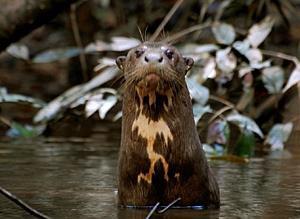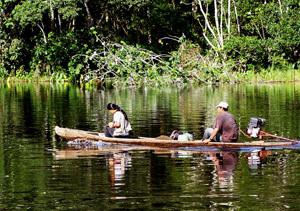Maribel Recharte
Other projects
4 Nov 2014
Giant Otter (Pteronura brasiliensis): Coexistence with People in the Peruvian Amazon
The project aims to reduce the threat to giant otters from fishermen seeking to protect fish stocks by demonstrating to communities that otters are actually indicators of healthy fish populations and well-managed fisheries.

Giant otter registered during census on the Yavari River, 2009.
The giant river otter (Pteronura brasiliensis) is the biggest otter in the Peruvian Amazon. This species was hunted extensively in the Peruvian Amazon during the period of trade in wild animal skins between 1920 and 1973, when the export of otter skins was prohibited, and the species was included in Appendix I of CITES. Between 1973 and 2004, giant river otter populations have experienced a slow recovery in numerous rivers of the Peruvian Amazon. Increasing giant otter populations means that otters are in contact with people more regularly. Giant otters are piscivores and fishermen see them as competitors for the overlapping in the consumption of fish. In particular, community members were concerned that the valuable ornamental arowana (Osteoglossum bicirrhosum) fishery was declining. Although arowana are occasionally eaten by giant otter, there is no evidence that otters impact on arowana populations.

Giant river otter census on Samiria River. Pacaya-Samiria National Park, Peru.
The populations of giant otters are recovering, but we don’t know exactly how many there are, or the distribution of the species in key areas. We will determine areas where conflict is most likely. We will study otter diet, and compare this with the species fished commercially. We will compare otter distribution with fish population data to determine whether otters affect fisheries, and in particular we will compare arowana densities with the distribution of giant otters. We will produce easy-to-understand educational materials and maps on otter and fish populations, demonstrating that giant otters indicate well managed fisheries. We will initiate community meetings to attempt to alleviate fishermen’s concerns about competition with otters and instil a sense of pride for otters and healthy fisheries near their communities.
The increase in otter populations is seen as favourable in some communities that are practising ecotourism. However, not all community members, and particularly not fishermen, participate in this activity. Where possible, we aim to confer the advantages of tourism more widely by encouraging dialogue and trade in food-fish between fishermen and community members working with tourism. We aim make long-term changes to the perception of giant otters as competitors for fish.